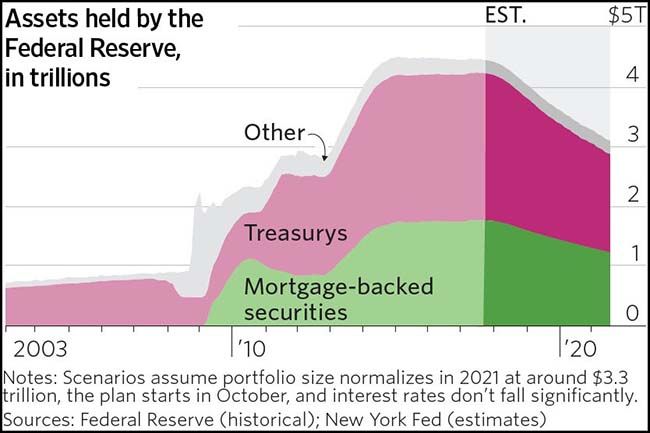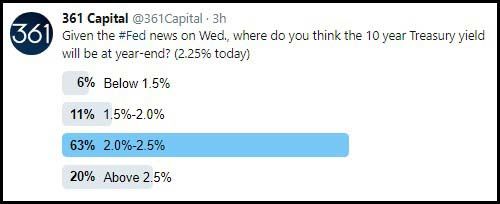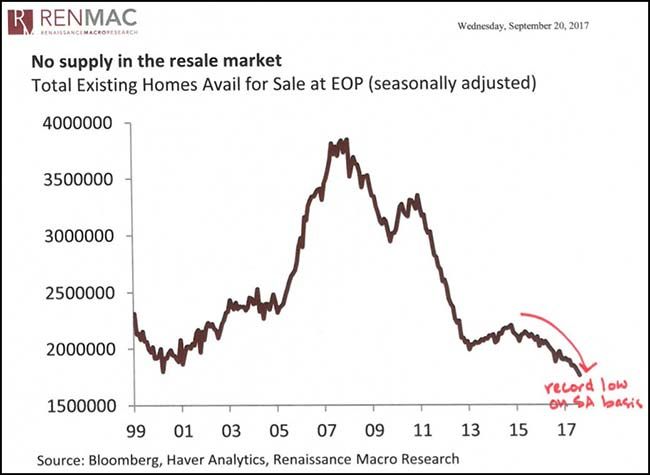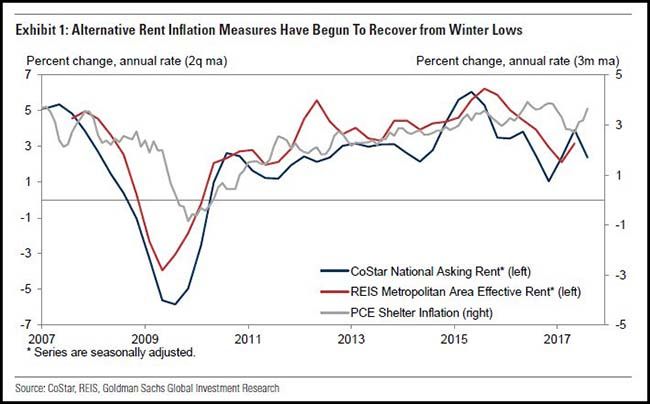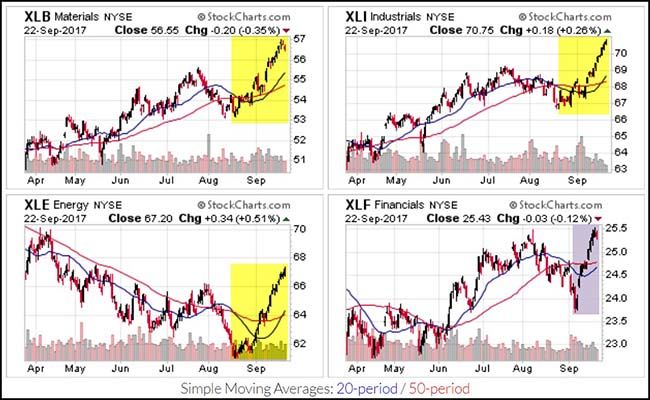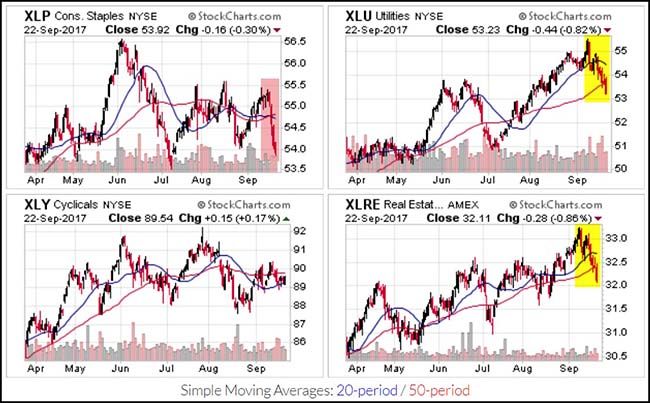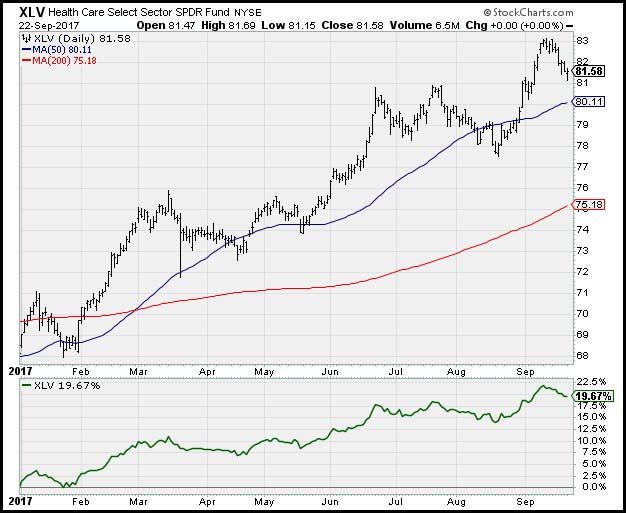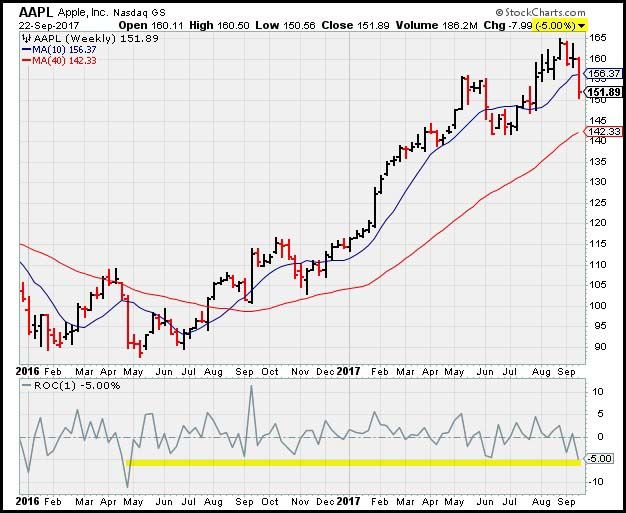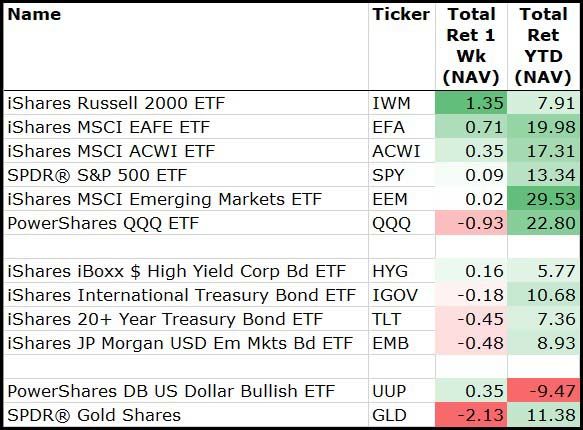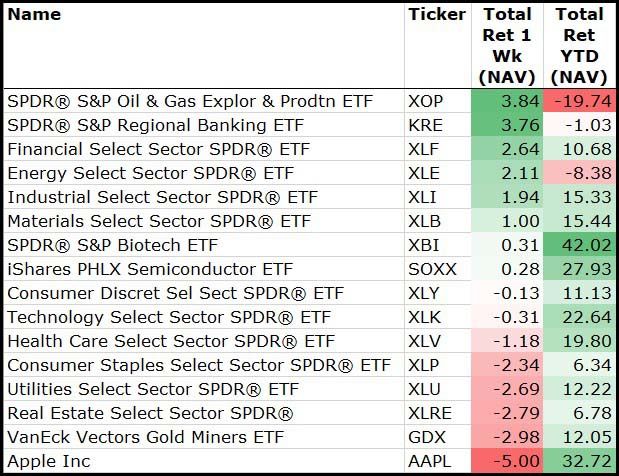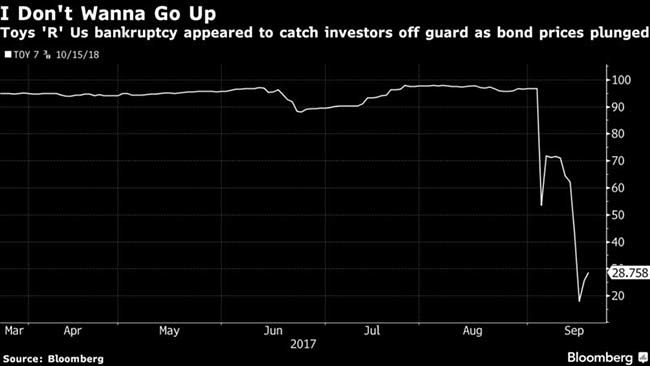by Blaine Rollins, CFA, 361 Capital
The Fed finally gave the signal to begin shrinking its balance sheet. As the Fed conveyed in its text release, and Janet emphasized in her Q&A, the economy is good and the time is right. And so it begins, although at a very slow pace. I was actually surprised that Janet didn’t put up a presentation poster showing the surge in the 2-year treasury yield. Had she done so to begin the Q&A, she could have dropped the mic, put on her Ray Bans and walked out of the meeting room. This new high in short-term Treasury yields is telling us all that the economy is strengthening and higher inflation lies ahead. Bits and pieces of inflation have been trickling through, but add the impact from three devastating hurricanes and you can bet that it will accelerate. The stock market began to take further notice this week as it again shifted from defensive, yield-oriented equities into economically cyclical and price dependent business models. Look at the moves in Energy, Industrials and Materials over the last month. Now compare that to the performances of Consumer Staples, REITs and Utilities. Stocks seem to be trying to tell us something. While the news flow seems to be focused on North Korea, Healthcare, Tax Reform and the NFL, maybe the year-end surprise will be in inflation and interest rates. Very few portfolio managers seem to be worried about it from what I can see in the surveys.
To receive this weekly briefing directly to your inbox, subscribe now.
Fed gives the green light to start shrinking the balance sheet…
“For October through December, the decline in our securities holdings will be capped at $6 billion per month for Treasuries and $4 billion per month for agencies. These caps will gradually rise over the course of the following year to maximums of $30 billion per month for Treasuries and $20 billion per month for agency securities and will remain in place through the process of normalizing the size of our balance sheet.” (Fed Reserve Chair Janet Yellen)
“The basic message here is U.S. economic performance has been good,” Fed Chairwoman Janet Yellen said at a press conference after a two-day policy meeting that ended Wednesday. “The American people should feel the steps we have taken to normalize monetary policy…are well justified given the very substantial progress we’ve seen in the economy.”
(WSJ)
The Fed did not raise interest rates this meeting, but they told you that it will happen soon enough…
Investors are still pretty sanguine about the direction of interest rates through year end…
Follow 361 Capital on Twitter to see more polls like this.
If you are looking for a large potential source of inflation, start with housing…
There is just no inventory to be had in the U.S. market—and this data is before the three hurricanes.
Goldman Sachs thought shelter inflation could remain low. But then the indexes began to shift upward…
Shelter cost is 17% of the core PCE index and over 40% of the core CPI index. The surprise in the recent data was that multifamily builds have been absorbed more quickly by the market. Again, this data doesn’t yet reflect the displacement of so many in Houston, Florida and Puerto Rico.
The labor shortage that homebuilder D.R. Horton is experiencing will run through to most of the U.S. construction industry…
While demand for housing remains robust, there is an acute shortage of homes for sale partly due to a lack of labor, which has weighed on the housing market for about two years.
Harvey and Irma could worsen the housing shortage as scarce labor is being used for the rebuilding efforts and materials are bid higher.
Irma, one of the most powerful Atlantic storms on record, killed more than 80 people in the Caribbean and the United States and followed Harvey, which killed more than 80 people when it struck Texas in late August and caused massive flooding in Houston.
D.R. Horton said at a RBC Capital Markets conference this month that Texas accounts for about 25 percent of the total number of homes that it sells, while Florida is about 20 percent.
(Reuters)
The trade war with Canada has also lifted U.S. lumber costs by over 20%…
The U.S. tariffs sent lumber prices surging at a time when demand from home builders was already strong, Butz said. While the lion’s share of the Canadian producers’ business is directly linked to lumber, the American companies have more investments in private U.S. timberlands and mills in the nation’s south, where log prices haven’t increased as much, he said.
“Prices have gone up, and the U.S. market has absorbed the prices,” said Philippe Couillard, the premier of Quebec, Canada’s second-largest lumber-exporting province. In Canada, “not a single worker has been laid off, not a single plant has been closed,” Couillard said in an Sept. 18 interview. “So the people suffering from this battle are the U.S. consumer and the people wanting to build their homes or renovate their homes.”
The trade dispute pushed up material costs for house builders in the U.S. by 20 percent, Jerry Howard, chief executive officer of the National Association of Home Builders, said last month.
On the Chicago Mercantile Exchange, lumber futures are up 25 percent over the past 12 months to $381.80 per 1,000 board feet. Prices have room to keep climbing, said Kevin Mason, managing director of Vancouver-based ERA Forest Products Research.
The inflation impact from the hurricanes will also impact the shipping costs of the entire U.S. by 5-7%…
Spot rates for shipping goods are on the rise as efforts begin to rebuild the areas of Texas and Florida that were hit by the recent hurricanes.
Industrywide, rates could rise by 5 to 7 percent in the next few weeks as trucks strain to get everything from food to roof trusses into parts of Houston and the Southeast hit hardest by Hurricanes Harvey and Irma. Difficult to reach areas could push rates in select circumstances up as high as 50 percent.
The process of bringing goods to aid in the recovery could add to rates over the next quarter, with upward price pressures likely spilling into 2018, affecting contract freight prices for the new year, according to industry analysts. Spot rates represent on-demand shipping, while contract rates cover longer-term agreements.
On a typical day, Texas and Florida account for about 7 percent of U.S. trucking activity and affect another 4 percent indirectly as freight passes through on its way to other regions, said Noël Perry, an analyst at FTR Transportation Intelligence, an industry research firm.
(Trucks)
So here is a chart of the 2-year Treasury yield…
As you can see, the stock market doesn’t like a weakness in the 2-year yield. Stocks have recently had good moves off the lows in the yield.
An accelerating 2-year yield seems to be causing the economy to chase economically sensitive groups…
Banks and Financials have recently joined the economically sensitive move, but will it continue to participate as the yield curve flattens?
(@HumbleStudent)
At the opposite side of the performance move, defensive and safe sectors have led the way lower…
And Amazon/Whole Foods looks like it is about to take all the manufacturer margins out of the grocery aisles as the new 52-week low list is littered with the Consumer Staple giants (CPB K KHC KR NWL MDLZ).
The pause in Health Care is due to the Obamacare repeal/replace discussions…
But the group should recover now that the Senate has basically killed the latest Graham Cassidy legislation.
And Apple sauce!
iPhone 8 (weak early sales), iPhone X (delayed introduction), iWatch (wireless network glitch), AppleTV (yawner reviews). Worst weekly performance in 17 months.
For the week, Small Caps carried the flag while a Gold iPhone was hazardous to your portfolio…
Among sector performance, Energy again led joined by Financials and Industrials. Safety was discarded.
Hutchin Hill’s boss is a very smart quant. Take notice that he is preparing for a big market move…
(Neil) Chriss said he estimates “a market correction of between 25 percent and 35 percent at some time in the future is likely,” based on his models. The firm has tuned its hedges for larger market moves. The cost of hedging will be eased with the elimination of the long-short credit strategy, the letter said.
You have to wonder if Neil Chriss’ caution is confirmed by the overzealous credit markets…
Illiquidistan: Tajikistan issued 10yr bonds this month. Less than 1bp of mankind can locate Tajikistan on a map. Nearly all are Tajiks. But the bonds paid 7.125% which is roughly what pensions need to prevent insolvency. Bahrain issued $3bln of 12yr paper at 6.75% ($15bln of bids). Iraq issued $1bln at 5yrs at 6.75%. Belarus issued 10yr paper at 7.63%. And Ukraine issued $3bln of 15yrs. $1.6bln rolled existing paper that nearly defaulted 2yrs ago when investors wrote off $3.6bln in debt and delayed payments for 4yrs. This new issue yielded 7.37%.
(EricPeters/OneRiverAM)
Speaking of overzealous, let’s talk about Geoffrey and the not-so-efficient market for Toys R Us bonds…
I always thought debt investors were smarter than equity ones. But events like this give me doubts. The bonds effectively evaporated in a month. What kind of efficient market does that? Investors in the debt were not betting on the financials and fundamentals of Toys R Us. They were betting entirely on the markets ability to refinance the debt. Think of playing hot potato with a rock that will burn a hole in your portfolio. Was the extra stretch in basis points worth not getting a return of your capital? Just crazy. Toys R Us’ fundamentals were in a death slide since WalMart became a coast to coast chain and Amazon sold its first nonbook.
While the difficulties of the debt-laden company had been broadcast to the market for some time, bond investors nevertheless appeared to be surprised by the events of this month. The price of Toys ‘R’ Us debt due 2018 plunged from 96 cents on the dollar on Sept. 5, around the time reports of a potential bankruptcy first began circulating, to a low of 20.2 cents on Sept. 18, when the company officially filed for protection.
Investors may have misjudged the ability of Toys ‘R’ Us to continue refinancing its debt, assuming that rampant demand for yield would ensure a continued stream of fresh funding from a broadening array of buyers including exchange-traded and mutual funds. For years the company had been rolling over its debt, often secured against the value of its land.
While I would put very low odds on Congress getting anything done this session, it is prudent to keep an eye on what they are working on for tax reform…
Details of the Republican tax plan have leaked out to various news outlets.
The reported details are as follows:
- The Top individual tax rate will be lowered to 35% from 39.6%.
- Corporate tax rate will be lowered to 20% from 35%.
- The standard deduction will be doubled which will reduce taxes for most middle income taxpayers.
- Will create a 25% tax rate for pass through business owners
- State and local tax deduction will be ended
(Briefing)
Finally, this video might change your ideas of Chinese high-speed rail safety…






